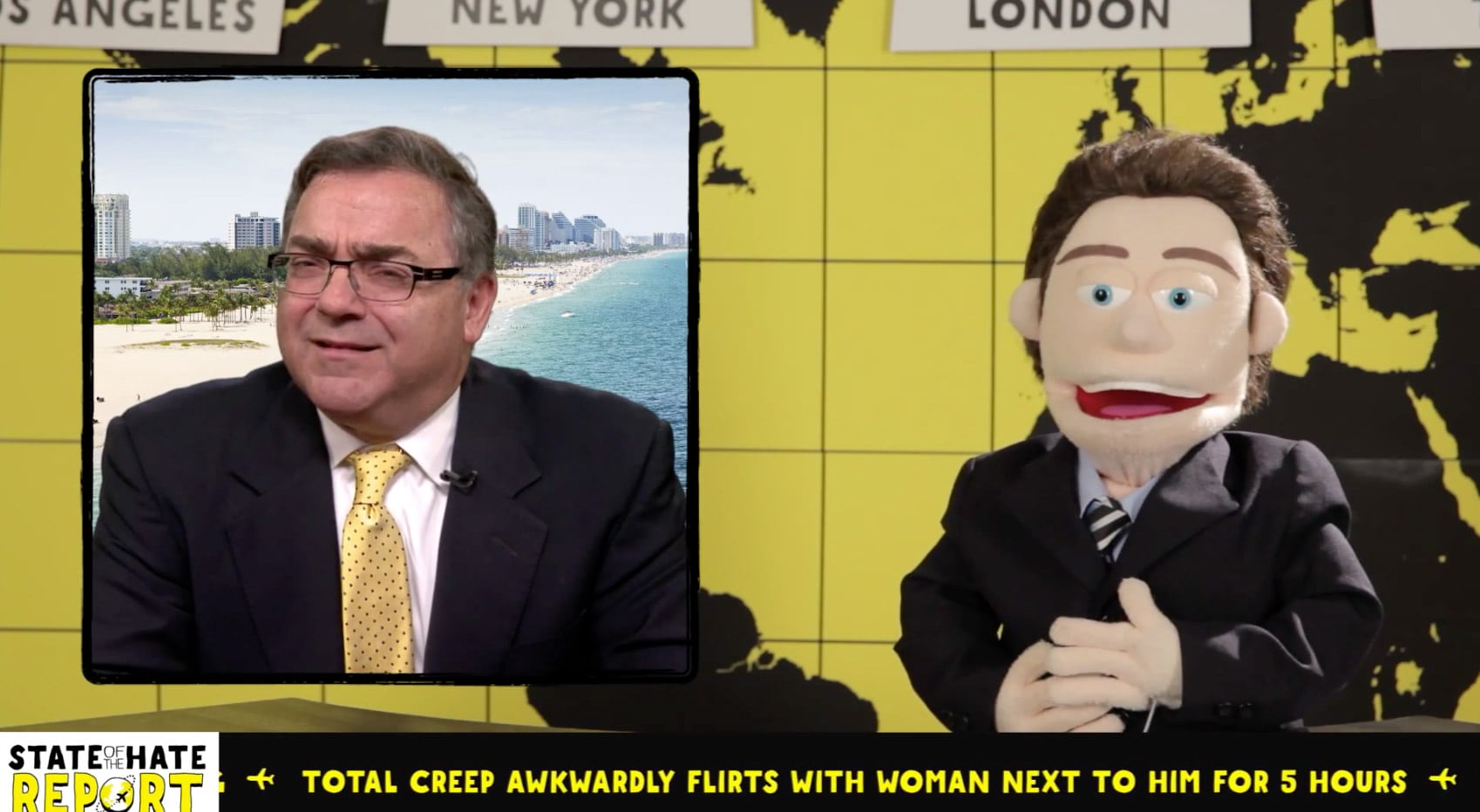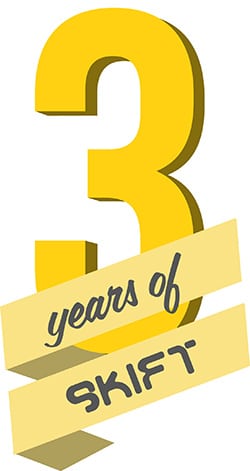Skift Take
Perhaps Baldanza spends a lot of time practicing his candor and approachability, but it's working.
It’s the question that plagues the U.S. aviation industry: How can Spirit Airlines grow, and profit, while steadfastly refusing to offer even the tiniest concession to passenger comfort free of charge?
Skift also wanted to know. So we asked.
The airline’s CEO, Ben Baldanza, was happy to answer our questions in plain terms, without corporate speak or condescension.
His demeanor, whether innate or expertly rehearsed, reflects the Bare Fares campaign that has become a cornerstone of the airline’s brand ethos over the last 18 months.
Spirit also has its Bare packing strategy, its State of Hate report, an AutoPilot-run Twitter feed, and, most recently Bundle and Unbundle —fake lawyers ready to fight the major carriers and get passengers refunds for products and services they never used, but paid for in bundled fares.
Baldanza characterises all of these stunts as part of the airline’s effort to explain the airlines operating model to customers, and set realistic expectations. But does it work? The numbers say yes.
Baldanza is proud that Spirit takes such a naked approach to doing business. What follows are excerpts from our revealing conversation with the likeable CEO of the U.S. airline everybody loves to hate.
Skift: How dare Spirit go Bare?
Baldanza: A few years ago, we noticed something interesting at Spirit, which is that we had kind of a bar bell in the customer response to our airline. There were customers who loved the airline, promoted the airline, loved saving money on the airline, and then we had another group of people at the opposite end of the spectrum who, while they really like the fare were very disappointed that we didn’t offer services that they traditionally associate with airlines. The kind of services many airlines provide.
We realized that there was enormous value in education and that the customers who understood the airline and the value proposition of the airline, had a much better chance of being happy with their purchase on Spirit, repeating purchases with Spirit, telling friends about it and things like that. So we partnered with branding agency, based in Kansas City, Missouri, the Barkley Group, to come up with ways we could be more transparent about our business model.
That’s where the term Bare Fare came up. We want to try to be more obvious to people that our fare is kind of a stripped-down naked fare. The idea of Bare Fare, simple as it sounds, should just in and of itself tell you that there’s something a little bit different about this than just a normal fare, and get people to understand a little better.
That’s just one small aspect of a broader initiative at Spirit in the way we talk to our customers on the website, the way we organize our airports, the language our reservations agents use, the way our airplanes look, the way we message to the media–all kinds of things. It’s all around a clearer understanding and more transparency around the true value proposition that Spirit offers, which is that we get you where you’re going for a lower price point, although they have to expect some compromise for that.
Skift: Long gone are the days of refurbished seats, dull livery, and that awkward “Catch the Spirit” jingle. Today’s Spirit has a growing fleet of new, more fuel efficient, environmentally friendly aircraft with fit-to-purpose pre-reclined seats, hand crafted in England by one of the industry’s growing independent seat suppliers, all wrapped up in that unmissable taxi-cab yellow and black branding. Why not sell the upside of your improvements?
Baldanza: We put a lot of seats in our airplanes. A lot of the feedback that we get is that there are certainly customers who understand that when you have more seats on the plane everyone can pay a lower price, and that’s one of the trade-offs our customers accept knowingly, and they’re OK with that. But we do invest in good seats, and they are leather seats, and in some ways they are better than other airlines. It certainly would be a little different for Spirit to go out and talk about how our seating is better and other airlines, given that we scrunch more seats on the plane. But we’ll consider touting the things that make Spirit a modern, fresh, good product too, not just someone who squeezes a lot of people onto the plane.
Skift: How scrunched is it really?
Baldanza: It’s about a 28-inch pitch in general. That’s not true in every row, of course. Exit rows are a little more and we have the Big Front Seat product at the front of the plane that’s a little more, but the tightest pitch on our planes is about 28 inches. Which, by the way, that’s not an uncommon pitch in the US, especially in the regional space. If you fly an American, United or Delta and you wind up flying a regional jet or on a turboprop plane and sit on 28-inch pitch, even though those airlines will say that they give you more leg room than that.
One advantage at Spirit, at least, is that, if you’re willing to pay a little bit more–and it truly is a little–you at least have the Big Front Seat product that you can say: “If I want a little more legroom, I can pay for a little more legroom and get it.”
Skift: You did an Ask Me Anything on Reddit. What were you thinking?
Baldanza: It’s all about transparency. We let like to address our business model and we find that the more that we talk about our business model—even people who are initially negative about the model—we find that generally improves the situation.
I’m not going to say that people who hate Spirit end up loving Spirit after we talk to them about it. I’m not suggesting that. But what happens is that there are a lot of misconceptions about what Spirit is and things we do or a lot of misunderstandings about why we do things.
Do we not pour you a glass of water for free because we’re mean? No. It’s very expensive to bring water onboard the airplane. The bottle of water isn’t expensive to buy, but its several hundred dollars to cater that cart to the airplane. The reality is that if we gave water away for free on the airplane we’d have to raise every ticket by $0.25 fare cents.
That process is what creates high fares over time. Once people start to understand that they still may not like it. They might still say: “Spirit’s not the airline for me because I’d rather pay $30 to get more legroom or a free can of Coke” or something—even though that’s a very expensive can of Coke—but they tend to understand it better.
So the Reddit AMA was all about just being completely open and transparent, not knowing who was going to talk to us but being able to respond to anything from a helpful comment to a real disgruntled customer. We’re just open to that kind of stuff because we want to be transparent.
Skift: Would you do it again?
Baldanza: Absolutely. I don’t know that the Reddit AMA format we’ll do again—and I’m not saying we won’t—but the idea of making ourselves available to reach fairly broad audiences that will likely include dissenters, not just fans, is absolutely a concept that we would do again.
Skift: Spirit is the airline nobody’s flying, but its planes are full. Are there closet Spirit flyers, do you think?
Baldanza: There are plenty of people who say they would never fly Spirit, and then they fly Spirit. Nobody likes to promote the fact that they shop at Walmart, but they’re the biggest retailer on the planet. People say what they want to do and then they behave in different ways sometimes.
Some people say they’ll never fly Spirit and they never do. Others say they won’t fly Spirit and then they do and we saved them $100 and they say: “This is worth it, I saved $100.”
We know one thing for sure. People fly us because our prices are low. We know they’re not choosing us because our seats are more comfortable, or because of any physical product feature. We know they’re saving money. We like that. That’s a really good basis for a sustainable and growing customer base when you can offer your customers the lowest possible price to make their travel happen for them.”
We really believe at Spirit that education is power and that, as long as the customers know clearly what they’re buying, that more people will understand and appreciate what Spirit offers, even they choose not to fly Spirit every once in a while. But, imagine if you lived in a place where the only restaurant in town was really expensive. You might like that a lower priced restaurant moved in. Not because you want to eat there every night, but it’s nice to have a choice once in a while.
I think the U.S. air travel space, the North American air travel, space is better with a Spirit and a JetBlue and a Delta than if there were only one airline, run like any one of us.
The Daily Newsletter
Our daily coverage of the global travel industry. Written by editors and analysts from across Skift’s brands.
Have a confidential tip for Skift? Get in touch
Tags: ceo interviews, low-cost carriers, spirit airlines
Photo credit: Spirit Airlines CEO Ben Baldanza, L, appearing in a promotional video pushing its 'Bare Fares.' Spirit Airlines

